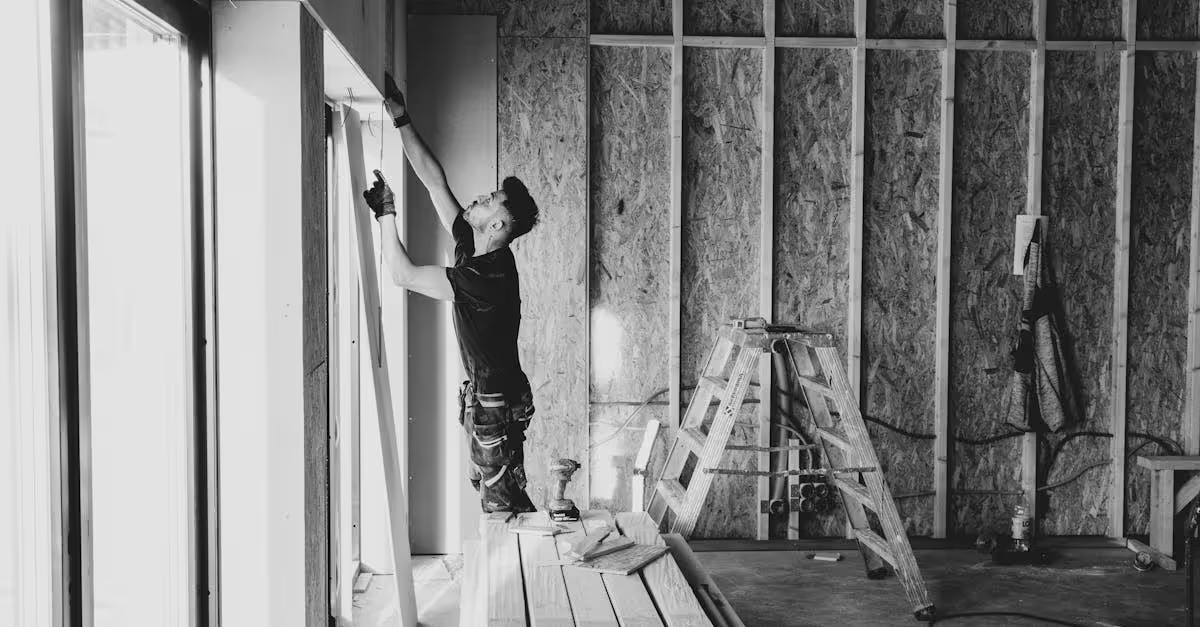Key Takeaways
- Enhanced Convenience: Pool automation systems enable remote control of cleaning, heating, and lighting, making pool management effortless and enjoyable.
- Cost and Water Savings: Automated systems can reduce maintenance costs by up to 70% and significantly decrease water usage, promoting efficiency.
- Key Features for Selection: Look for user-friendly apps, advanced scheduling, integrated sensors, and security features when choosing an automation system.
- Installation Preparation: Assess existing pool equipment for compatibility and necessary upgrades before installation to avoid potential issues.
- Regular Maintenance Practices: Conduct routine inspections, clean filters, update software, and test safety features to ensure optimal performance of your automation system.
- Upgrading Existing Systems: Consider enhancements like remote control capabilities and safety features to improve your pool experience while ensuring compatibility with current equipment.
As pool owners, we know that a well-functioning pool can enhance our outdoor experience and increase property value. In fact, studies show that automated pool systems can save up to 70% on maintenance costs and significantly reduce water usage. With renovation season upon us, there's no better time to consider installing or upgrading our pool automation systems.
Understanding Pool Automation Systems
Pool automation systems simplify management and monitoring, transforming our backyard oasis into a stress-free haven. They allow us to control various features like lighting, heating, and cleaning from our phones, making it easy to enjoy a swim any time.
Benefits of Automation
Automation brings numerous benefits to pool owners. We can save up to 70% on maintenance costs, using automated systems for cleaning and safety inspections. These systems also enhance water efficiency, keeping usage low while ensuring our pools remain inviting. Convenience stands out; we can schedule cleaning or heating remotely. Imagine lounging indoors while our pool gets ready for a swim! Safety features, such as automatic covers, protect our families, giving us peace of mind. Lastly, increased property value is a bonus, as prospective buyers appreciate modern, efficient pool setups.
Key Features to Look For
When researching automation systems, several key features warrant consideration. User-friendly mobile apps allow us to control our pools remotely, so we can enjoy seamless pool management. Advanced scheduling lets us set up routines for cleaning and heating, tailored to our lifestyles. Integrated sensors provide real-time monitoring, alerting us to any issues that arise. Automated lighting enhances ambiance as we host evening gatherings with friends. Connectivity to home networks enables easy updates; we can even control our system with voice commands. Lastly, security features such as alarms and safety covers keep our loved ones secure while we enjoy the water. By assessing these features, we select the best solution to upgrade our pool experience.
Preparing for Installation or Upgrade
Preparing for a pool automation system installation or upgrade involves key steps to ensure a smooth process. We focus on assessing our current setup and identifying specific renovation needs.
Assessing Your Current System
We begin by evaluating existing equipment, including pumps, heaters, filters, and lighting systems. Checking compatibility with the new automation system is vital. For instance, Jandy’s automation systems work seamlessly with major brands like Hayward and Pentair. Identifying outdated components now helps prevent unexpected issues later. Think of it like a family dinner: if the pasta’s overcooked, no one enjoys the meal. Let’s not serve up any surprises when we unveil our new automated features.
Installation Process
Installing or upgrading a pool automation system involves clear steps for a successful transition. Our focus lies on preparation and execution, emphasizing compatibility and system integration.
Required Tools and Equipment
- Central Controller: This component acts as the automation system's brain, typically located near the pool’s equipment pad. It connects to other elements efficiently.
- Wiring and Conductors: Essential for linking the controller to all major parts like pumps and lights.
Gathering these tools in advance streamlines the process and keeps everything organized. Setting things up is easier when we know what’s needed and where everything goes.
Step-by-Step Guide
- Assess Existing Equipment: Start with a thorough evaluation of pumps, heaters, filters, and lighting systems. Compatibility with the new automation system matters greatly.
- Discuss Customization Options: Collaborate with the installer about preferred schedules and configurations. Discussing features like water fountains or spa jets helps tailor the setup to our lifestyle.
- Install the Central Controller: Position it close to the pool's equipment pad for easy access to wiring and maintenance.
- Wiring Connections: Connect the wiring from the central controller to the pumps, heaters, and lights. Ensure all connections are secured properly.
- System Testing: After installation, conduct a thorough test of the system to confirm all components operate as expected. Testing guarantees everything works smoothly.
Following these steps will help simplify the installation process. Our experience with automation systems can turn our pools into convenient retreats.
Upgrading Existing Systems
When upgrading existing pool automation systems, we're making significant improvements to our poolside experience. Careful evaluation of current equipment helps streamline the process.
Compatibility Considerations
Evaluate existing equipment, including pumps, heaters, filters, and lighting systems. Some products, like Jandy's AquaLink RS, offer conversion kits. These solutions simplify installation by avoiding extensive rewiring. Kits usually work with top brands, such as Hayward and Pentair, so compatibility plays a critical role in the upgrade. Updating outdated components prevents unexpected issues down the road. Always double-check if the new system supports essential features like mobile connectivity, especially if we're looking at advanced functions. Staying ahead with our choices guarantees a smoother transition to automation.
Enhancements to Consider
Consider the features that upgrade our pool systems. Look for mobile options that allow us to control settings remotely. Integrated sensors provide real-time monitoring, which can be a lifesaver when managing pool cleanliness. Scheduling cleaning and heating through a user-friendly app is a game changer. Additional safety features, such as automatic covers, add layers of security for our families. Route management software can help schedule maintenance services, ensuring timely upkeep. As we explore enhancements, think about how these upgrades support our lifestyles and elevate our outdoor experiences. With the right system, our pools transform into low-maintenance enjoyment zones rather than burdens. What’s on your list of must-have features?
Maintenance and Troubleshooting
Regular upkeep and addressing issues quickly keep our pool automation systems running smoothly. Let’s explore essential practices and solutions.
Regular Maintenance Tips
- Inspect components regularly. Check pumps, heaters, and controllers weekly for signs of wear or damage. Quick fixes today can prevent larger problems tomorrow.
- Clean filters often. Clear debris from filters at least once a month for optimal performance. Clogged filters can waste energy and reduce efficiency.
- Update software regularly. Keep the automation system’s software up to date for access to new features and security improvements. Just like having the latest phone, it keeps us connected with smart features.
- Test safety features. Inspect pool covers and alarms monthly. Confirm they operate correctly; maintenance of these elements is crucial for safety.
- Schedule seasonal maintenance. Once a year, have a professional technician check the entire system. They can fine-tune settings and spot potential issues before they snowball.
Common Issues and Solutions
- Unresponsive controller. If the controller doesn’t respond, restart the system. If problems continue, check wiring connections. Sometimes a loose wire is the culprit.
- Inconsistent water temperature. If the heater struggles to maintain temperature, inspect filter cleanliness. Clogged filters can restrict water flow, leading to fluctuating temperatures.
- Lighting failures. If pool lights fail, first check the bulb. If that's not the issue, inspect the wiring and connections. Bright lights can transform our night swims!
- Poor water circulation. If we notice debris pooling in corners, check pump function. A malfunctioning pump can lead to stagnant water, which is less inviting for a dip.
- Connectivity issues. If the mobile app won’t connect, ensure the home's Wi-Fi signal reaches the pool area. Sometimes, we just need to reboot the Wi-Fi router.
Conclusion
Embracing pool automation during renovations is a game changer for enhancing our outdoor spaces. By investing in these systems, we not only save time and money but also elevate our overall pool experience. With the right features and careful planning, we can create a seamless and enjoyable environment for family and friends.
As we prepare for installation or upgrades, it's crucial to assess our current setups and choose compatible components. Regular maintenance and troubleshooting ensure that our systems continue to operate efficiently. Let’s take the plunge and transform our pools into effortless retreats that we can enjoy all season long.
Frequently Asked Questions
What are the benefits of automated pool systems?
Automated pool systems enhance outdoor experiences by simplifying management and monitoring. They can save up to 70% on maintenance costs and reduce water usage. These systems allow for remote control of features like lighting, heating, and cleaning, making pool ownership more convenient and enjoyable.
How do pool automation systems increase property value?
Pool automation systems can significantly increase property value by offering modern amenities that appeal to potential buyers. The convenience and efficiency of automated features attract buyers looking for low-maintenance outdoor living spaces, ultimately enhancing the property's marketability.
What features should I look for in a pool automation system?
Key features to consider include user-friendly mobile apps, advanced scheduling options, integrated sensors for real-time monitoring, automated lighting, home network connectivity, and safety features such as automatic covers. These capabilities contribute to a seamless pool ownership experience.
How can I prepare for installing a pool automation system?
Assess your current setup by evaluating existing equipment like pumps, heaters, and filters for compatibility with the new automation system. Identifying any outdated components early can help avoid unexpected issues during the upgrade process, ensuring a smooth transition.
What are the steps for installing a pool automation system?
Start by assessing your existing equipment for compatibility, then discuss customization options with your installer. Next, install the central controller, make wiring connections, and conduct thorough system testing to ensure everything operates correctly.
What should I consider when upgrading an existing pool automation system?
Evaluate your current equipment for compatibility with new systems. Look for products that offer conversion kits, like Jandy's AquaLink RS, which can simplify installation. Ensure that the new system supports essential features, such as mobile connectivity and real-time monitoring.
How can I maintain my pool automation system?
Regular maintenance tips include inspecting components weekly, cleaning filters monthly, updating software, and testing safety features annually. Scheduling professional maintenance once a year can help ensure your system runs smoothly and efficiently.
What are common issues with pool automation systems?
Common issues include unresponsive controllers, inconsistent water temperatures, lighting failures, poor water circulation, and connectivity problems with mobile apps. Following troubleshooting steps and regular maintenance can help resolve these issues effectively.






